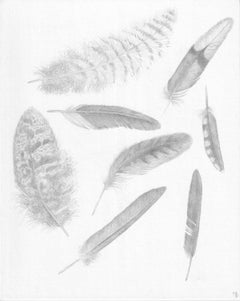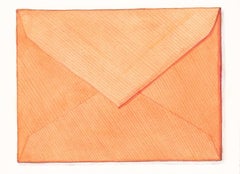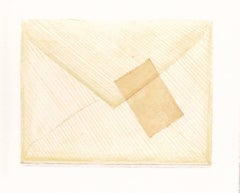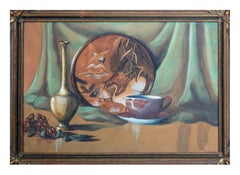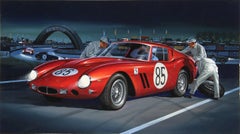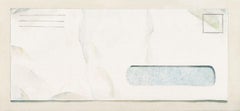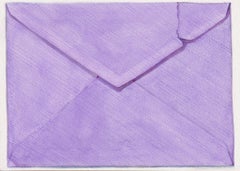Board Drawings and Watercolor Paintings
to
3
Overall Width
to
Overall Height
to
3
3
2
1
2
11,002
19
16
9
9
36
163
46
24
12
3
3
Medium: Board
Artist: Margot Glass
Feather Group Four - Silverpoint Drawing Bird Feathers Soft Gray White, 2021
By Margot Glass
Located in Kent, CT
This contemporary drawing is made with silverpoint on prepared archival board. The exploration of ephemerality, and the fragility of nature, its textures and movement, is the focus o...
Category
2010s Contemporary Board Drawings and Watercolor Paintings
Materials
Silver
Orange Envelope, Watercolor and pencil realist still life, 2016
By Margot Glass
Located in New York, NY
Margot Glass explores the fragility of communication, and people’s natural drive to find narrative in even the most ordinary of objects. In her Envelopes series, Glass works in water...
Category
2010s Contemporary Board Drawings and Watercolor Paintings
Materials
Watercolor, Illustration Board, Pencil
Light Envelope with Tape, realist watercolor and pencil still life, 2016
By Margot Glass
Located in New York, NY
Margot Glass explores the fragility of communication, and people’s natural drive to find narrative in even the most ordinary of objects. In her Envelopes series, Glass works in water...
Category
2010s Contemporary Board Drawings and Watercolor Paintings
Materials
Watercolor, Illustration Board
Related Items
Three Cranes, Mid-Century Watercolor Still Life
By Laurelda Cecille Schmidt
Located in Soquel, CA
Elegant mid-century watercolor still-life with grapes, a vase, and fine china depicting three cranes by Laurelda Cecille Schmidt (American, 1903-1994). Presented in a giltwood frame...
Category
1940s American Impressionist Board Drawings and Watercolor Paintings
Materials
Watercolor, Cardboard
$1,395
H 14 in W 20 in D 1 in
Ferrari Berlinetta 563, circa 1964, Gouache Illustration by Jack Leynnwood
By Jack Leynnwood
Located in Long Island City, NY
This gouache painting on illustration board was created by American artist Jack Leynnwood. Fascinated by aviation from a young age, Leynnwood did kit illustrations of everything from military aircraft to rigged ships, Rat Finks, Flash Gordon, space ships and Ed “Big Daddy...
Category
1960s Photorealist Board Drawings and Watercolor Paintings
Materials
Gouache, Illustration Board
Machine Age Industrial WPA Era American Scene Social Realism Mid 20th Century
By Jo Cain
Located in New York, NY
Machine Age Industrial WPA Era American Scene Social Realism Mid 20th Century
Jo Cain (1904 - 2003)
Elliot
17 ¼ x 35 ¾ inches
Gouache on board, c. 1930s
Signed lower left
27 x 46 in...
Category
1930s Board Drawings and Watercolor Paintings
Materials
Gouache, Board
$8,500
H 27 in W 46 in D 2 in
'Old Reliable', Early American Modernist, Jalopy, Model T Ford Flatbed Truck
Located in Santa Cruz, CA
An American School watercolor showing an old Ford Model T flatbed truck backed up to a barn in a rural landscape.
A well-composed work painted in a harmonious palette by an accomplis...
Category
1920s Board Drawings and Watercolor Paintings
Materials
Watercolor, Gouache, Illustration Board
$950
H 13.75 in W 20 in D 0.07 in
Rick Owens Hollywood show. From the Fashion series
Located in Miami Beach, FL
The artist has covered New York collections for over 16 years and has interviewed, as a journalist, several fashion designers and personalities for different publications. He loves t...
Category
21st Century and Contemporary Contemporary Board Drawings and Watercolor Paintings
Materials
Paper, Pencil, Gouache
$650
H 15 in W 11 in D 0.1 in
Harvest Time The Hills of Mt Tamalpais near Lake Bon Tempe 1890s
Located in Soquel, CA
Harvest Time The Hills of Mt Tamalpais near Lake Bon Tempe 1890s
The Hills around San Rafael in the 19th century were a time of work and play as seen in this watercolor near Lake Bon...
Category
Late 19th Century American Impressionist Board Drawings and Watercolor Paintings
Materials
Watercolor, Illustration Board, Laid Paper
$1,800
H 21.75 in W 11.5 in D 0.07 in
Whimsical Illustration Hiking Cartoon, 1938 Mt Tremblant Ski Lodge William Steig
Located in Surfside, FL
Lighthearted Illustration of Outdoor Pursuits This one being cross country hiking signed "W. Steig"
Provenance: from Mrs. Joseph B. Ryan, Commissioned by Joe Ryan for the bar at his ski resort, Mount Tremblant Lodge, in 1938.
Mont Tremblant, P.Q., Canada
Watercolor and ink on illustration board, sights sizes 8 1/2 x 16 1/2 in., framed.
In 1938 Joe Ryan, described as a millionaire from Philadelphia, bushwhacked his way to the summit of Mont Tremblant and was inspired to create a world class ski resort at the site. In 1939 he opened the Mont Tremblant Lodge, which remains part of the Pedestrian Village today. This original illustration is on Whatman Illustration board. the board measures 14 X 22 inches. label from McClees Galleries, Philadelphia, on the frame backing paper.
William Steig, 1907 – 2003 was an American cartoonist, sculptor, and, in his later life, an illustrator and writer of children's books. Best known for the picture books Sylvester and the Magic Pebble, Abel's Island, and Doctor De Soto, he was also the creator of Shrek!, which inspired the film series of the same name. He was the U.S. nominee for both of the biennial, international Hans Christian Andersen Awards, as a children's book illustrator in 1982 and a writer in 1988.
Steig was born in Brooklyn, New York in 1907, and grew up in the Bronx. His parents were Polish-Jewish immigrants from Austria, both socialists. His father, Joseph Steig, was a house painter, and his mother, Laura Ebel Steig, was a seamstress who encouraged his artistic leanings. As a child, he dabbled in painting and was an avid reader of literature. Among other works, he was said to have been especially fascinated by Pinocchio.He graduated from Townsend Harris High School at 15 but never completed college, though he attended three, spending two years at City College of New York, three years at the National Academy of Design and a mere five days at the Yale School of Fine Arts before dropping out of each.
Hailed as the "King of Cartoons" Steig began drawing illustrations and cartoons for The New Yorker in 1930, producing more than 2,600 drawings and 117 covers for the magazine. Steig, later, when he was 61, began writing children's books. In 1968, he wrote his first children's book. He excelled here as well, and his third book, Sylvester and the Magic Pebble (1969), won the Caldecott Medal. He went on to write more than 30 children's books, including the Doctor DeSoto series, and he continued to write into his nineties. Among his other well-known works, the picture book Shrek! (1990) formed the basis for the DreamWorks Animation film Shrek (2001). After the release of Shrek 2 in 2004, Steig became the first sole-creator of an animated movie franchise that went on to generate over $1 billion from theatrical and ancillary markets after only one sequel. Along with Maurice Sendak, Saul Steinberg, Ludwig Bemelmans and Laurent de Brunhofff his is one of those rare cartoonist whose works form part of our collective cultural heritage.
In 1984, Steig's film adaptation of Doctor DeSoto directed by Michael Sporn was nominated for the Academy Award for Best Animated Short Film. As one of the most admired cartoonists of all time, Steig spent seven decades drawing for the New Yorker magazine. He touched generations of readers with his tongue–in–cheek pen–and–ink drawings, which often expressed states of mind like shame, embarrassment or anger. Later in life, Steig turned to children's books, working as both a writer and illustrator.
Steig's children's books were also wildly popular because of the crazy, complicated language he used—words like lunatic, palsied, sequestration, and cleave. Kids love the sound of those words even if they do not quite understand the meaning. Steig's descriptions were also clever. He once described a beached whale as "breaded with sand."
Throughout the course of his career, Steig compiled his cartoons and drawings into books. Some of them were published first in the New Yorker. Others were deemed too dark to be printed there. Most of these collections centered on the cold, dark psychoanalytical truth about relationships. They featured husbands and wives fighting and parents snapping at their kids. His first adult book, Man About Town, was published in 1932, followed by About People, published in 1939, which focused on social outsiders. Sick of Each Other, published in 2000, included a drawing depicting a wife holding her husband at gunpoint, saying, "Say you adore me."
According to the Los Angeles Times, fellow New Yorker artist Edward Sorel...
Category
1930s Naturalistic Board Drawings and Watercolor Paintings
Materials
Archival Ink, Watercolor, Illustration Board
Cuban Artist - Caricature of Adolphe Menjou Debonair Devil
Located in Miami, FL
Framed Cuban Artist/Caricaturist Conrado Walter Massaguer presents Hollywood star Adolphe Menjou in a satirical dual portrait. In the foreground, the subject is seen in a dapper top hat, tux, fashionable cigarette and boutonnière, and is shown as being the epitome of being stylishly debonair. To make a larger point about this subject, Massaguer paints a cast shadow of Menjou as a burning red devil who studies his alter ego from above. Keeping with the artist's sarcasm, we see the good and bad in one image. Works by Massaguer are rare and this work is in keeping with his signature style. This work was most likely done on assignment for Life Magazine, Cosmopolitan, The New Yorker or Vanity Fair. Signed upper right. Inscribe lower right. Titled on verso. Unframed, Slight bend to board; toning to board; scattered faint foxing; pin point abrasions to margins, not affecting image. 19-1/2 x 15-1/8 inches board size.
Conrado Walter Massaguer y Diaz was a Cuban artist, political satirist, and magazine publisher. He is considered a student of the Art Nouveau. He was the first caricaturist in the world to broadcast his art on television.He was first caricaturist to exhibit on Fifth Avenue. He was the first caricaturist in the world to exhibit his caricatures on wood. He, and his brother Oscar, were the first magazine publishers in the world to use photolithographic printing.
Self portrait of Conrado Walter Massaguer, depicted on a carrousel ride, with the devil over his left shoulder and an angel over his right. (1945)
He created the magazine Social with his brother Oscar to showcase Cuban artistic talent. The duo later created the magazine Carteles, which became for a period the most popular magazine in Cuba, which was purchased by Miguel Ángel Quevedo in 1953.
In his life, he met and drew caricatures of Franklin D. Roosevelt, Walt Disney, Albert Einstein, the King of Spain, and many others.[ In sum total, he was the author of more than 28 thousand caricatures and drawings.Ernest Hemingway once had to refrain himself from punching Massaguer in the face after the artist drew an unflattering caricature of him. The dictator Gerardo Machado, however, did not punch Massaguer for his own unflattering caricature - he had the artist deported.
He was one of the most internationally renowned Cuban artists of his day, and his art is still regularly featured in galleries across the Western Hemisphere and Europe.
Early life
Massaguer was born on October 18, 1889, in Cárdenas, Cuba.[In 1892, his family moved to Havana.
When the Cuban War of Independence broke out, Massaguer's family escaped the country. From 1896 to 1908, he lived in Mérida, Mexico. However, during this time, his parents enrolled him in the New York Military Academy, where he stayed during school years.
In 1905, after graduating the military academy, he briefly attended the San Fernando school in Havana, where he was tutored by Ricardo de la Torriente and Leopoldo Romañach.
In 1906, less than a year later, he returned to the family home in Mexico.
Career as artist
Early career
While living in Yucatán, Mexico, Massaguer published his first caricatures in local newspapers and magazines. These included La Campana, La Arcadia, and the Diario Yucateco.
In 1908, he moved back to Havana. After returning to the island in 1908, Massaguer began mingling with Havana's aristocratic circles, forming close friendships with some of the city's most powerful and influential men, as well as winning the favor of many women who were quickly charmed by him. Massaguer, largely self-taught, honed his style using the avant-garde techniques he studied from the European and American magazines that were widely available in Cuba at the time.
Cover of the immensely popular Cuban magazine El Figaro, drawn by Massaguer in 1909. This cover depicts two bumbling, incompetent American tourists to the island.
He started drawing for El Fígaro, and was featured prominently on the cover in 1909.
After two years of refining his craft, Havana announced a poster contest aimed at attracting North American tourists to stay in the city during the winter months. Notable figures like Leopoldo Romañach, Armando Menocal, Rodríguez Morey, Jaime Valls, and others also entered the competition. The jury was particularly impressed by the modern execution and creative solution of one piece, signed by Massaguer, who was relatively unknown at the time.
The jury deliberations caused a great controversy.[5] The prize was ultimately awarded to the Galician painter Mariano Miguel, who had recently married the daughter of Nicolás Rivero, the wealthy owner of the conservative newspaper Diario de la Marina. Although Massaguer received only an honorable mention, the fraud scandal caused such an uproar that his name quickly entered the public spotlight, and he became an overnight sensation.
In 1910, he became co-owner of the advertising agency Mercurio, with Laureano Rodríguez Castells. At Mercurio, he led the Susini cigar campaign, and earned substantial wealth.
Massaguer has been described as a restless man, in both mind and body.After earning enough money from his art to begin traveling, he was almost always doing so. He constantly traveled between New York City and Havana, Mexico and France, Europe and the Americas.
In 1911, his reputation among the Havana socialites solidified when he organized his own first public caricature exhibit, and also the first Caricature Salon ever held in the Americas, hosted at Athenaeum of Havana (the Ateneo), and the Círculo de La Habana. Other exhibitors here included Maribona, Riverón, Portell Vilá, Valer, Botet, Barsó, García Cabrera, Carlos Fernández, Rafael Blanco, and Hamilton de Grau.
"Messaguer Visits Broadway." Caricatures of theatrical and literary figures. Elsie Janis, Raymond Hitchcock, S. Jay Kaufman (columnist), Ibanez, author of The Four Horsemen, and Frances White
In 1912, in the New York American Journal, he published his first Broadway drawings.
From 1913 to 1918, he was an editor for Gráfico.
Social
Main article: Social (magazine)
Cover of the magazine Social, July 7, 1923
In 1916, he created the magazine Social with his brother, Oscar H. Massaguer. Social's contributors included Guillén Carpentier, Chacón y Calvo, Enrique José Varona and others.Social has been described as Massaguer's great love in the magazine industry, and was the property that historians say he cared the most about. Social was an innovative magazine, being the first magazine in the world to use a modern printing process called photolithographic printing.
Social set cultural trends, not only in the fashion of Cuba, but in art, politics, and Cuban identity.[11] Social catered to a certain aesthetic in Cuba - that of the sophisticated elite socialite - but Massaguer would also use this magazine to ridicule and jibe against that same class of society when he found their personalities worthy of his contempt.
In Social, readers could find a variety of content, including short stories, avant-garde poetry, art reviews, philosophical essays, and serialized novels, as well as articles on interior design, haute couture, and fashion. Occasionally, the magazine also featured reports on sports such as motor racing, rowing, tennis, and horse riding.The cultural promotion efforts of both Massaguer and Emilio Roig de Leuchsenring are evident in the magazine. Notably, this period overlaps with their involvement in the Minorista Group, which was then at the forefront of the country's intellectual life.[5] Many contributors were devoted members of the group, leading some experts to consider Social as the cultural voice of the Minoristas.
One of the features of Social magazine was its section called "Massa Girls," which was a play on his own name, and pronounced with a glottal 'g' in a similar fashion to the letter in Massaguer.[12] Massaguer drew women as independent and free-thinking, and never drew the woman celebrity as a caricature of herself, but as a free agent surrounded by caricatures.[11] However, Massaguer himself has been described as a womanizer in his personal life, and hesitant to fully embrace every facet of women's liberation.
In 1916, he also established la Unión de Artes Gráficas and the advertising agency Kesevén Anuncios.[9]
The art critic Bernardo González Barroa wrote:
“Massaguer has solved the problem of working hard, living comfortably off what his art produces and not missing any artistic, sporting or social event. His broad, childish laugh, of a carefree individual who carries his luck hidden in a pocket, appears everywhere for the moment, disguising the pranks of pupils that lurk, mock and, finally, flash with satisfaction at finding the characteristic point after having analyzed a soul... Massaguer's personality is beginning to solidify now. He has been the best-known and most popular caricaturist for a long time, but his technique had not reached the security, the mastery of values that he presents in his latest works, which is very natural and explainable”[5]
Carteles
Main article: Carteles
Cover of the magazine Carteles, November 29, 1931
In 1919, Massaguer and his brother created the magazine Carteles.[9] Carteles gained the widest circulation of any magazine in Latin America, and the most popular magazine in Cuba for a time, until that title was claimed by Revista Bohemia. Carteles remained in print until July 1960.This magazine showcased Cuban commerce, art, sports, and social life before the revolution.
In 1924, Carteles took a more political turn, with articles criticizing Gerardo Machado's government. it became a prime example of the humor and graphic design employed by artists like Horacio Rodríguez Suria and Andrés García...
Category
1930s Art Nouveau Board Drawings and Watercolor Paintings
Materials
Watercolor, Ink, Illustration Board
$12,500
H 16.38 in W 12.5 in
British Mid 20th Century watercolour on board still life painting of flowers
Located in Petworth, West Sussex
Derrick Latimer Sayer (British, 1917 – 1992)
A vase of summer blooms
Watercolour on board
24.3/4 x 16.3/4 in. (60.3 x 42.5 cm.)
Sayer studied at the Chelsea School Art under Henry Mo...
Category
20th Century Expressionist Board Drawings and Watercolor Paintings
Materials
Watercolor, Board
$746
H 24.75 in W 16.75 in D 1 in
Church Interior
By Ray Quigley
Located in Buffalo, NY
A modern illustration by American artist Ray Quigley depicting two men inside of a church.
Category
1950s Realist Board Drawings and Watercolor Paintings
Materials
Gouache, Illustration Board, Ink
Secret Garden 3 - 21st Century, Flowers, Drawing, Black, White, Contemporary
By Alina Aldea
Located in Baden-Baden, DE
Secret Garden 3, 2019
White ink on black cardboard
39 3/8 H x 27 9/6 W in.
100 H x 70 W cm
The drawings signed by Alina Aldea show the meticulousness and perfection of microscopic o...
Category
2010s Contemporary Board Drawings and Watercolor Paintings
Materials
Ink, Cardboard
$1,126
H 43.31 in W 31.5 in D 3.94 in
Summer Set 8, watercolor monoprint (unique) on Dieu Donne handmade paper, signed
By Arlene Shechet
Located in New York, NY
Arlene Shechet
Summer Set 8, 2005
Watercolor monoprint on dieu donné hand made paper
21 × 27 1/2 inches
Signed and dated in graphite on the front
Exquisite watercolor monoprint on di...
Category
Early 2000s Contemporary Board Drawings and Watercolor Paintings
Materials
Watercolor, Handmade Paper, Monoprint, Mixed Media, Graphite
Previously Available Items
Safety Envelope with Window, contemporary realist watercolor still life
By Margot Glass
Located in New York, NY
Margot Glass' miniature watercolor and graphite envelopes are reminiscent of love notes and pen pals. Her array of diminutive, jewel-toned envelopes remind us of the delicacy and poe...
Category
2010s American Realist Board Drawings and Watercolor Paintings
Materials
Watercolor, Board, Graphite
Violet Envelope, contemporary realist watercolor still life
By Margot Glass
Located in New York, NY
Margot Glass' miniature watercolor and graphite envelopes are reminiscent of love notes and pen pals. Her array of diminutive, jewel-toned envelopes remind us of the delicacy and poe...
Category
2010s American Realist Board Drawings and Watercolor Paintings
Materials
Watercolor, Board, Pencil
Envelope with Shadow, contemporary realist watercolor still life
By Margot Glass
Located in New York, NY
Margot Glass' miniature watercolor and graphite envelopes are reminiscent of love notes and pen pals. Her array of diminutive, jewel-toned envelopes remind us of the delicacy and poe...
Category
2010s American Realist Board Drawings and Watercolor Paintings
Materials
Watercolor, Board, Pencil
Thank You Note, contemporary realist watercolor still life
By Margot Glass
Located in New York, NY
Margot Glass' miniature watercolor and graphite envelopes are reminiscent of love notes and pen pals. Her array of diminutive, jewel-toned envelopes remind us of the delicacy and poe...
Category
2010s American Realist Board Drawings and Watercolor Paintings
Materials
Watercolor, Board, Pencil
Kraft Envelope Envelope, contemporary realist watercolor still life
By Margot Glass
Located in New York, NY
Margot Glass' miniature watercolor and graphite envelopes are reminiscent of love notes and pen pals. Her array of diminutive, jewel-toned envelopes remind us of the delicacy and poe...
Category
2010s American Realist Board Drawings and Watercolor Paintings
Materials
Watercolor, Board, Pencil
Envelope with String Tie, contemporary realist watercolor still life
By Margot Glass
Located in New York, NY
Margot Glass' miniature watercolor and graphite envelopes are reminiscent of love notes and pen pals. Her array of diminutive, jewel-toned envelopes remind us of the delicacy and poe...
Category
2010s American Realist Board Drawings and Watercolor Paintings
Materials
Watercolor, Board, Pencil
Ruby Envelope, contemporary realist watercolor still life, 2021
By Margot Glass
Located in New York, NY
Margot Glass' miniature watercolor and graphite envelopes are reminiscent of love notes and pen pals. Her array of diminutive, jewel-toned envelopes remind us of the delicacy and poe...
Category
2010s American Realist Board Drawings and Watercolor Paintings
Materials
Watercolor, Board, Pencil
Cartier Envelope, contemporary realist watercolor still life
By Margot Glass
Located in New York, NY
Margot Glass' miniature watercolor and graphite envelopes are reminiscent of love notes and pen pals. Her array of diminutive, jewel-toned envelopes remind us of the delicacy and poe...
Category
2010s American Realist Board Drawings and Watercolor Paintings
Materials
Watercolor, Board, Pencil
Rose Envelope, contemporary realist watercolor still life, 2021
By Margot Glass
Located in New York, NY
Margot Glass' miniature watercolor and graphite envelopes are reminiscent of love notes and pen pals. Her array of diminutive, jewel-toned envelopes remind us of the delicacy and poe...
Category
2010s American Realist Board Drawings and Watercolor Paintings
Materials
Watercolor, Board, Pencil
Seagull Feather, Silverpoint Drawing of Bird's Feather in Soft Gray on White
By Margot Glass
Located in Kent, CT
This delicate drawing is made with silverpoint on prepared archival board. The exploration of ephemerality, and the fragility of nature, its textures and movement, is the focus of th...
Category
2010s Contemporary Board Drawings and Watercolor Paintings
Materials
Silver
Dove Feather Two, Small Silverpoint Drawing of Feather in Soft Gray
By Margot Glass
Located in Kent, CT
This delicate drawing is made with silverpoint on prepared archival board. The exploration of ephemerality, and the fragility of nature, its textures and movement, is the focus of th...
Category
2010s Contemporary Board Drawings and Watercolor Paintings
Materials
Silver
Dove Feather Three, Small Silverpoint Drawing of Feather in Soft Gray on White
By Margot Glass
Located in Kent, CT
This delicate drawing is made with silverpoint on prepared archival board. The exploration of ephemerality, and the fragility of nature, its textures and movement, is the focus of th...
Category
2010s Contemporary Board Drawings and Watercolor Paintings
Materials
Silver
Board drawings and watercolor paintings for sale on 1stDibs.
Find a wide variety of authentic Board drawings and watercolor paintings available on 1stDibs. While artists have worked in this medium across a range of time periods, art made with this material during the 21st Century is especially popular. If you’re looking to add drawings and watercolor paintings created with this material to introduce a provocative pop of color and texture to an otherwise neutral space in your home, the works available on 1stDibs include elements of blue, purple, orange, red and other colors. There are many well-known artists whose body of work includes ceramic sculptures. Popular artists on 1stDibs associated with pieces like this include George Wachsteter, Reginald K. Gee, Alina Aldea, and Margot Glass. Frequently made by artists working in the Contemporary, Abstract, all of these pieces for sale are unique and many will draw the attention of guests in your home. Not every interior allows for large Board drawings and watercolor paintings, so small editions measuring 0.1 inches across are also available Prices for drawings and watercolor paintings made by famous or emerging artists can differ depending on medium, time period and other attributes. On 1stDibs, the price for these items starts at $1 and tops out at $1,595,000, while the average work can sell for $894.
